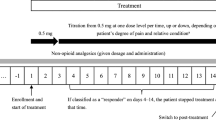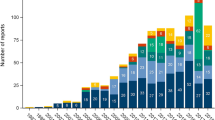Abstract
Background
World Health Organization (WHO) guidelines, Agency for Health Care Policy and Research (AHCPR) clinical practice guidelines, and EAPC recommendations indicate oral route of opioid administration as the preferred route. Transdermal administration of opioids is considered an alternative when patients cannot take medications orally. Moreover, WHO and EAPC indicate orally administered morphine as the first-choice drug for the treatment of moderate to severe cancer-related pain. However, we can see that in Italy there is an increasing use of transdermal fentanyl (TF) as first-choice strong opioid (and route) even when oral administration of opioids is possible.
Aims
The aims of this study are to describe the modality in the use of TF administration in two settings of care, taking into consideration (1) the drugs previously taken by the patients, (2) the reasons for switching from any drug to TF, (3) the conversion ratio used, and (4) the frequency of “inappropriate use of transdermal fentanyl according to the WHO guidelines and the EAPC recommendations”, i.e., switching to fentanyl patch from any drug, even if there were no contraindications in using oral morphine. The settings of care considered were the out-patient palliative care unit (OP-PCU) and the oncological wards (OWs) of the National Cancer Institute (NCI) of Milan.
Patients and methods
The clinical charts of 98 patients prescribed with and given fentanyl patch for the first time at the NCI of Milan in 2002 were reviewed and the data gathered were grouped according to the administration of fentanyl at the OP-PCU (63 out-patients) or at the OWs (35 in-patients). Summary descriptive statistics and bar and box plots have been used. Fisher two-tailed exact text was applied to test the differences between in- and out-patients.
Results
Before switching to TF, (1) in-patients were more frequently treated with nonsteroidal anti-inflammatory drugs (NSAIDs) and weak opioids (mostly tramadol) in respect to the out-patients (44.1 vs 25.8%) who were mostly treated with oral morphine (48.4 vs 20.6%) (p=0.045), and (2) 88.7% of the out-patients were treated with oral opioids and only 1.6% with parenteral opioids in respect to OWs where 69.7% were on oral opioids and 18.2% on parenteral opioids (p=0.006). In 29% of out-patients and in 53% of in-patients, changing to fentanyl patch was considered as “inappropriate” (p=0.028) according to the WHO guidelines and the EAPC recommendations. No statistically significant differences between the two settings were observed regarding the reasons for switching and the conversion ratio used.
Conclusions
There is a trend to use fentanyl patch as first-choice strong opioid in cancer patients in situations such as titration phase, in the presence of instable pain, and in the absence of dysphagia or gastrointestinal symptoms where the use of oral morphine is, however, not contraindicated.


Similar content being viewed by others
References
World Health Organization (1986) Cancer pain relief. World Health Organization, Geneva, Switzerland
World Health Organization (1996) Cancer pain relief, 2nd edn. World Health Organization, Geneva, Switzerland
World Health Organization (1999) Model list of essential drugs (EDL), 11th edn. Available at http://www.who.int/medicines/organization/par/edl/infed 111 group.litml
Hanks GW, De Conno F, Ripamonti C et al (Expert Working Group of the European Association for Palliative Care) (1996) Morphine in cancer pain: modes of administration. BMJ 312:823–826
Hanks GW, De Conno F, Cherny N et al (Expert Working Group of the Research Network of the European Association for Palliative Care) (2001) Morphine and alternative opioids in cancer pain: the EAPC recommendations. Br J Cancer 84(5):587–593
Jacox A, Carr DB, Payne R et al (Agency for Health Care Policy and Research (AHCPR) Pharmacological Management) (1994) Recommendations. In: Management of cancer pain. Clinical Practice Guideline No 9. U.S. Department of Health and Human Services, Public Health Service, AHCPR Publication No 94-0592, March, Rockville
Gourlay GK (2001) Treatment of cancer pain with transdermal fentanyl. Lancet Oncol 2:165–172
Chinellato A, Terrazzani G, Walley T, Giusti P (2003) Opioids in Italy: is marketing more powerful than the law? Lancet 362:78
De Conno F, Ripamonti C, Brunelli C (2005) Opioid purchases and expenditure in nine western European countries. “Are we killing off morphine?” Palliat Med 19:179–184
Radbruch L, Nauck F, Sabatowski R (2002) Germany: Cancer pain and palliative care—current situation. J Pain Symptom Manage 24(2):183–187
Kornik CA, Santiago-Palma J, Moryl N, Payne R (2003) Benefit–risk assessment of transdermal fentanyl for the treatment of chronic pain. Drug Saf 26(13):951–973
Skaer TL (2004) Practice guidelines for transdermal opioids in malignant pain. Drugs 64(23):2629–2638
Scottish Intercollegiate Guidelines Network (SIGN) (2000) Cancer pain guidelines. SIGN, Edinburgh
Gourlay GK, Kowalski SR, Plummer JL et al (1989) The transdermal administration of fentanyl in the treatment of postoperative pain: pharmacokinetics and pharmacodynamic effects. Pain 37:193–202
Korke W, de Stoutz N, Morant R (1996) Day-to-day titration to initiate transdermal fentanyl in patients with cancer pain: short- and long-term experiences in a prospective study of 39 patients. J Pain Symptom Manage 11:139–146
Portenoy RK, Southam MA, Gupta SK et al (1993) Transdermal fentanyl for cancer pain: repeated dose pharmacokinetics. Anesthesiology 78:36–43
Varvel JR, Shaker SL, Hwang SS et al (1989) Absorption characteristics of transdermally administered fentanyl. Anesthesiology 70:928–934
Holley FO, Van Steennis C (1988) Postoperative analgesia with fentanyl: pharmacokinetics and pharmacodynamics of constant-rate IV and transdermal delivery: Br J Anaesth 60:608–613
Gourlay GK, Kowalski SR, Plummer JL et al (1990) The efficacy of transdermal fentanyl in the treatment of postoperative pain: a double-blind comparison of fentanyl and placebo systems. Pain 20:21–28
Mystakidou K, Befon S, Kouskouni E, Gerolymatos K, Georgaki S, Tsilika E, Vlahos L (2001) From codeine to transdermal fentanyl for cancer pain control: a safety and efficacy clinical trial. Anticancer Res 21:2225–2230
Burza M, Ginobbi P, Fusco G, Laurenzi L, Tirelli W, Arcuri E (1998) Transdermal route as an alternative to oral administration of opioids in cancer pain. Clin Ter 149(4):277–280
Van Seventer R, Smit JM, Schipper RM, Wicks MA, Zuurmond WWA (2003) Comparison of TTS-fentanyl with sustained-release oral morphine in the treatment of patients not using opioids for mild-to-moderate pain. Curr Med Res Opin 19(6):457–469
Tawfik MO, Bryuzgin V and Kourteva G (FEN-INT-20 Study Group) (2004) Use of transdermal fentanyl without prior opioid stabilization in patients with cancer pain. Curr Med Res Opin 20(3):259–267
Vielvoye-Kerkmeer A, Mattern C, Uitendaal MP (2000) Transdermal fentanyl in opioid-naïve cancer patients: an open trial using transdermal fentanyl for the treatment of chronic cancer pain in opioid-naïve patients and a group using codeine. J Pain Symptom Manage 19:185–192
Janssen, LP (2005) Important drug warning. http://www.fda.gov/medwatch/SAFETY/2005/duragesic_ddl.pdf
Megens A, Artois K, Vermeire J et al (1998) Comparison of the analgesic and intestinal effects of fentanyl and morphine in rats. J Pain Symptom Manage 15:253–257
Ahmedzai S, Brooks D (1997) Transdermal fentanyl versus sustained-release oral morphine in cancer pain: preference, efficacy, and quality of life—the TTS-fentanyl Comparative Trial Group. J Pain Symptom Manage 13:254–261
Donner B, Zenz M, Tryba M et al (1996) Direct conversion from oral morphine to transdermal fentanyl: a multicenter study in patients with cancer pain. Pain 64:527–534
Payne R, Mathias SD, Pasta DJ et al (1998) Quality of life and cancer pain: satisfaction and side effects with transdermal fentanyl versus oral morphine. J Clin Oncol 16:1588–1593
Cherny N, Ripamonti C, Pereira J, Davis C, Fallon M, McQuay H, Mercadante S, Pasternak G, Ventafridda V (Expert Working Group the Research Network of EAPC) (2001) Strategies to manage the adverse effects of oral morphine: an evidence-based report. J Clin Oncol 19:2542–2554
Radbruch L, Sabatowski R, Loick G, Kulbe C, Kasper M, Grond S, Lehmann KA (2000) Constipation and the use of laxatives: a comparison between transdermal fentanyl and oral morphine. Palliat Med 14:111–119
Author information
Authors and Affiliations
Corresponding author
Rights and permissions
About this article
Cite this article
Ripamonti, C., Fagnoni, E., Campa, T. et al. Is the use of transdermal fentanyl inappropriate according to the WHO guidelines and the EAPC recommendations? A study of cancer patients in Italy. Support Care Cancer 14, 400–407 (2006). https://doi.org/10.1007/s00520-005-0918-0
Received:
Accepted:
Published:
Issue Date:
DOI: https://doi.org/10.1007/s00520-005-0918-0




